Message 164, Dec 16, 2003
Hi all, To me one of the most fascinating helmets is the APH-6, yet it is as if it has
been overlooked in our discussions in the old flightgear forum. Everybody knows what an
APH-6 looks like but surprisingly few hard facts are around. I have tried to compile some
of it as follows:
The APH-6 specification MIL-H-22995(Wep) was issued on 27 July 1961 and at the same time
the APH-6 appeared in Sierra Engineering's catalogue.
In 1968 the APH-6A and APH-6B appear in Gentex' catalogue, the A-model with a single visor
and the B-model with three-piece ramshorn dual visor.
25 April 1969 the specification is updated to become MIL-H-22995A(AS) but I do not know
how it differs from the original spec. Visors are not covered by the spec so it has
nothing to do with the emergence of the dual visor. Same year APH-6A and APH-6B also
appear in Sierra's catalogue, the B-model with a one-piece ramshorn dual visor.
My first evidence of the APH-6C and -6D models is in 1971. Both Sierra and Gentex received
orders from DSA that year for APH-6 helmets. I have noted a Sierra APH-6C dual visor and a
Gentex APH-6D single visor from that year but both manufacturers are known to have
delivered both helmet models.
From 1975 Sierra helmets change designation to APH-6DL, APH-6DM etc. but I am quite
certain that they are not new helmet models. All the DL helmets I have seen are size Large
and all the DM helmets are Medium. I therefore interpret the extra letter as an indication
of size.
The latest US Navy order for APH-6 helmets that I have come across was issued in 1977, and
I think it unlikely that many more were ordered. In fact, in an August 1978 letter Chief
of Naval Operations concluded that the APH-6 helmet combined with the A-13A (MS22001) mask
"no longer meets operational requirements". The HGU-33/P and HGU-34/P entered
into service in 1981, but the APH-6 specification was not cancelled until 31 August 1992.
So far, so good. Now gentlemen, does any of you know what the differences are between
single visor models APH-6, APH-6A and APH-6D, and the differences between the dual visor
models APH-6B and APH-6C?
Differences are evident in pictures but it is difficult to be certain which changes are
type-specific and which are field modifications and upgrades.
Any light shed on this sadly overlooked helmet is welcome (especially blue light ;-))
Cheers, Ahem, well, Bluelight
Message 3554, Jul 22, 2001
Hi Downwind28, The Navy APH-6B has what was known as the Navy "anti-flash"
(nuclear) shell and suspension straps, the theory being that white was more reflective of
nuclear flash effects than dark colors. These items were also used with a white MA-2 type
"nuclear" harness in US Navy aircraft such as the A-3/RA-5 Vigilante, and light
colored flight clothing. However, if this set were completely correct, I would have
expected the gold nuclear anti-flash visor to be in place for use with the white mask
suspension set; it is possible that the visor was traded out after the helmet and mask set
were used on actual nuclear missions, or that the mask and suspension set were added from
another APH-6B that still had the gold visor.
Thanks for sharing the photos with us.
Cheers, DocBoink
Message 3548, Jul 22, 2001
I have two helmets which I cannot clearly "type designate". Perhaps someone can
help me here (pics attached).
The second one is a APH-6B and looks genuine in and out. However, I would like to know
more about the white MS22001 shell assembly, including the white straps - any info on
this? Who used them typically? The mask is dated 80.
Thanks and regards,
downwind28
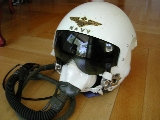
Message 1894:
Hello people again from sunny Spain. Got this helmet some time ago, and I thought may be
somebody could tell me something about it. It seems to have been used on T28 flown by the
Marines ? Any ideas?
By for now Atoll (also known as Miguel)
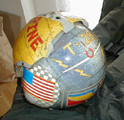
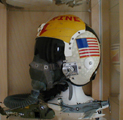
Message 1497:
I have noticed a trend on E-Bay and it may have something to do with the distribution of
US flight equipment. I am just thinking out loud and welcome any comments.
I would say that during the cold war, a substantial number of USAF aircraft may well
have been deployed in Europe. I noticed early on when dealing with European collectors
that they had quite an array of USAF flight gear, but were not as well stocked on US Navy
equipment. In fact, I made quite a few trades of Navy equipment for International
equipment. It would seem that the "demand" for US Navy equipment has created a
sort of conversion process for sellers on E-Bay. What was a USAF helmet can be cleaned up
and marketed as a US Navy helmet to fetch a higher price.
One of the things that is disturbing to me is the very high premium some collectors are
willing to pay for "decorated" helmets. Especially when the helmet has a nice
fresh coat of paint and shows no sign of wear. Coupled with the confusion over USAF vs US
Navy helmets, it would seem there are a lot of cross over items that are simply not
authentic. I am interested in hearing the opinions of others as regards to the paint
jobs and decorations that adorn some of these flight helmets and also would like to hear
from others on the US Navy Vs USAF helmets.
The USAF life support guys told me they didn't use Navy helmets AT ALL. Perhaps because
the helmets are all cut from about the same mold, literally. To put this in perspective:
The APH-5 and HGU-2 are the same helmet shell. The HGU-22/P is the same shell as the
HGU-2 which is the basis for the HGU-26/P.
This next part is probably going to get me in a jam, but here goes anyway. The USAF tried
to cut the HGU-22/P shell back at the 3, 9 and 12 o'clock position to increase visability.
It was discovered that these cuts waekened the shell .So the USAF jumped on the HGU-33/P
shell (PRK-37/P) for the HGU-48/P which was the basis for the HGU-55/P.
That means there are basically 2 helmet shells for most of the USAF/USN helmets and would
mean that cross use between services is unecessary. Even the APH-6 is the early
shell with o-mask cut outs.
For the record, I have a report on the HGU-48/P that verifies the use of the HGU-33/P
shell. This should also explain why the Navy could transition with little effort to the
HGU-55/P. Cause the -33 is a -55 with a visor assembly....
Now you may talk amongst yourselves. For the record, my parents were married. Cheers,
Steve N
Message 1292:
Hello all, Who can help me out to identify exactly what helmet model this is (looks like
an APH-6) and what parts are needed to re-do the interior. (pads, liner etc.) The helmet
was used on the UH-1 an AH-1 of the USMC during the Vietnam war. Are there any TO's or
NAVAIRS available for this helmet? Thanks in advantage, Sven Scheffers
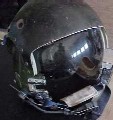
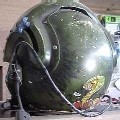
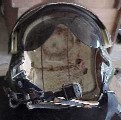
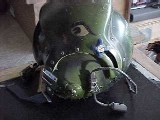
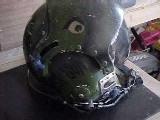
APH-6A helmet modified with ramshorn double visor and
updated comms (non-standard comm cord) © Venz
All pictures are thumbnails.
Message 779:
Chris Thanks for the comments, you and Steve really confirmed my suspicions about this
one. Believe it or not the guy that sold it to me thought it was a P series helmet. The
visor mechanism was worked by pulling the visor down, a plexiglass lug was glued on to the
visor to grab on to. The visor locked in the down position. To unlock and raise the visor
you pushed on the button in the center of the pivot point. The mechanism really did not
work too well, it would spring up at the slightest bump. The padding looks to be the same
as my current APH-5, the padding was very high quality, and well done. There were no
markings what so ever on the helmet, just the metal tag on the commo cord, and I cannot
remember what it was, but it was a standard US plug. Bill
Message 778:
Greetings all Thanks Steve and Chris for the thoughts. In another couple of weeks, after I
get my new scanner I will post better pictures of this helmet, these were copies made with
a digital camera. Hopefully you will be able to see better details. I cant tell if the
oxygen mask receivers are bulkier, because I did not have an APH-6 to compare it to. (too
new for me). I have also heard the same comment about the visor mechanism. It would make
sense that it was not used, it did not work very well. I could never keep the visor down,
a slight bump would send it springing up. The helmet was definitly US. The commo was
standard US, and the group of helmets that it was with were all US, and all Navy,
including an H-1(ox-mask snaps on leather tabs) that I got. The other helmets were APH
types, and a few different pressure types including the "clam shell" one. Bill
Message 759:
Regarding the "Mystery Helmet", This is an exciting discovery, Bill. I read
Steve N's comments and might agree with him that it could be a USN prototype that was
never put into production (it has to be either this or the fact that it is a custom built
helmet, which I find less than likely). The time frame of early 60s would appear to be
correct, for reasons of incorporation of the USN ratchet-type mask receivers, as well as
the fact that use of an uncovered visor was still a "conventional" concept at
that time (although about to be replaced with the covered visor concept). Steve's
observations about the visor mechanisms (on each side of the visor bracket bar) appearing
to share a resemblance to the USN Mk.IV type helmet visor system are
noteworthy--especially in the absence of any apparent visor track or securing knob. This
would seem to be the principle by which the visor was secured in a fully "Up" or
fully "Down" position (just like the Mk.IV or the clam-shell). I seem to recall
having seen similarly treated butter-leather covered ear cushions on another USN helmet
before, of roughly the same period, but my memories of this are very fuzzy. The cushions
on this helmet appear to match the standard USN APH-5 type forehead, crown, and occipital
pads, in terms of the leather material used. One other thing I noticed, although the
photos are too dark to make out distinct details clearly, is that the left side 02 mask
ratchet receiver unit appears to be built up more substantially on its upper edge
(something that the right side unit does not seem to feature). Not sure what the
significance of this would be. I downloaded prints of the images for better viewing and
noted that the Styrofoam liner appears to be a three piece unit and although the crown pad
is missing, you can see outlines of glue which formerly adhered it to the liner. Further,
the small metal clip-retainers that appear to hold the small conformational edgeroll
molding in place, above and below the mask receivers, are clearly contemporary with
certain APH-5 & APH-6 type design features (such as appear on the visor cover lower
edges of the APH-5 helmet, and also on some later versions of the APH-5A and APH-6 helmet
edgerolls). Thanks for sharing this interesting discovery with us, Bill. Hopefully someone
in the group may have more 'hard' data on it, or recognize it. Cheers, Chris
Message 757:
Bill, Neat helmet and looks like it was well done. I have no early documentation on the
APH-6 development program but I suspect it could be a prototype APH-6 for the following
reasons:
1- The old style earcups and pads.
2- No discs on the attach points for the earcups. I have a 1960 dated APH-6 and this is
the way the earcups attach on it.
3- The oxygen mask receivers seem a bit bulkier than on the standard APH-6. Are they? I
couldn't tell from the picture.
4- Visor mechanism looks almost like that being used on the MK-IV pressure suit helmet.
Possibly a design being considered? Is it possible the helmet is non US Equipment?
Interesting find! Cheers, Steve Norris
Message 755:
Greetings all, I have attached a couple of photos of a helmet that I had in my collection.
It was with a group of Navy helmets, and it appears to have the APH-6 style Ox mask
sockets, and no chin strap. The helmet was very well made. I suspect that it might have
been a custom job. With all that expertise out there, does anyone have any ideas about
what this is? Bill


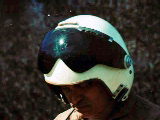
Message 338:
White, two piece Styrofoam liners were used in later APH-6 and PRK-37/P helmet assemblies.
These liners are very hard to find, but VTEC liners are everywhere. It was inevitable that
APH-6 helmets with VTEC liners would start showing up. Preliminary evidence indicates that
the APH-6 could not use the VTEC liners due to the contour of the APH-6 helmet and the
lack of an edgeroll to hold the liner in place. Steve Norris
Message 198:
Recently, an American Aviation dealer sold an APH-6 flight helmet on E-Bay with a VTEC
liner. I have contacted a number of you off line and no one seems to be able to verify
this configuration for an APH-6. Does anyone have documentation that the VTEC was used in
the APH-6? Thanks all, Steve Norris
Message 112:
It appears the PRU-36/P was in service and used on later APH-6s several years before the
PRK-37/P entered service. What I think this means is that the Rams Horn was out of Naval
Service prior to the arrival of the PRK-37/P Shell. Translation: It couldn't have been
used because it wasn't available when the PRK-37/P came into use. Still trying to nail a
spec reference or QPL on the Rams Horn. Cheers, Steve